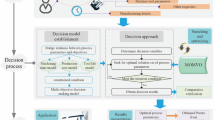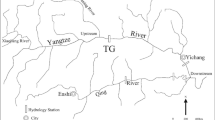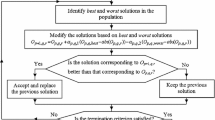Abstract
For process parameter optimization in high-speed dry hobbing, an optimization decision method is proposed in this study based on the multi-objective whale optimization algorithm (MOWOA). Firstly, according to the characteristics of high-speed dry hobbing, the processing time and processing error models are constructed; considering the carbon quota energy conservation and environmental protection policy, the processing cost model is established. Founded on the above models, the fitness function of the multi-objective optimization model is proposed. Afterward, on the basis of the traditional single-objective whale algorithm, the non-dominant set and crowding calculation method is introduced to establish a multi-objective optimization whale algorithm model. On this basis, the Pareto solution set is obtained. Finally, the actual decision case is compared to verify the effectiveness of the proposed method. Furthermore, the optimization data of MOWOA and several commonly multi-objective algorithms are compared to analyze the characteristics of the optimization solution set, thus verifying the superiority of the process parameter optimization method based on MOWOA.












Similar content being viewed by others
Availability of data and materials
The raw/processed data required to reproduce these findings cannot be shared at this time due to technical or time limitations.
Code availability
Not applicable.
Abbreviations
- m (mm):
-
Workpiece modulus
- z :
-
Number of teeth
- β (rad):
-
The helix angle of workpiece
- α n (rad):
-
The pressure angle of workpiece
- n (r/min):
-
Spindle rotation speed
- f (mm/r):
-
Feed rate (axial direction)
- q :
-
Hob threads
- v a (mm/min):
-
Axial feed speed
- D (mm):
-
Hob diameter
- v r (mm/min):
-
Radial feed speed
- B (mm):
-
Tooth width
- B 1 (mm):
-
Cutting length
- L 1 (mm):
-
Cutting-in route
- L 2 (mm):
-
Cutting-out margin
- L 3 (mm):
-
Cutting-in margin
- A (rad):
-
Installation angle
- h a (mm):
-
Addendum
- T total (min):
-
Processing time
- T a (min):
-
Air cutting time
- T m (min):
-
Cutting time
- T w (min):
-
Tool withdrawal time
- T e (min):
-
Tool changing time
- T au (min):
-
Assistance time
- T ex (min):
-
Time of tool change
- N tg :
-
Grinding times
- T l (min):
-
Tool life (once)
- T cw (min):
-
Assistance time of workpiece movement
- T sz (min):
-
Assistance time of loading and unloading parts
- T oa (min):
-
Operating assistance time
- P c (CNY):
-
Processing cost
- B c (CNY):
-
Ground billet cost
- L c (CNY):
-
Labor cost
- E cost (CNY):
-
Electric power cost
- M c (CNY):
-
Depreciation cost of machine tool
- T cost (CNY):
-
Tool cost
- Q c (CNY):
-
Carbon quota purchase cost
- R i (CNY):
-
Scrap returns income
- B v (cm3):
-
Gear blank volume
- G v (cm3):
-
Volume of post-hobbing
- ρ (kg/cm3):
-
Material density
- P br (CNY/kg):
-
Recycling unit price of round billet
- P b (CNY/kg):
-
The unit price of round billet
- m f :
-
Margin coefficient
- d a (mm):
-
Addendum circle
- c* :
-
Tip clearance coefficient
- x n :
-
Modification coefficient
- h r (CNY/min):
-
Hourly pay
- W m (kwh):
-
Energy consumption by the processing of each workpiece
- e p (CNY/kwh):
-
Electricity price
- m c (CNY/min):
-
Depreciation cost of machine tool
- T p (CNY):
-
Hob price
- s c (kgCO2):
-
Carbon emission per single piece processing
- c p (CNY/kg):
-
Carbon emission index per unit price
- C t (kg):
-
Total carbon emissions for the year
- q f (kg):
-
Free carbon quota
- F e (kgCO2/kwh):
-
Carbon Emission Factor
- e w :
-
Weight
- e x (μm):
-
Tooth direction error
- e y (μm):
-
Tooth profile error
- Q e (μm):
-
Processing error
References
BP (2021) Statistical review of world energy 2021. 70th ed. The British Petroleum Web. https://www.bp.com/en/global/corporate/energy-economics/statistical-review-of-world-energy.html. Accessed 28 Oct 2021
He WJ, Zhang B, Li YX, Chen H (2021) A performance analysis framework for carbon emission quota allocation schemes in China: perspectives from economics and energy conservation. J Envir Manag 296:1–12
Karpuschewski B, Knoche HJ, Hipke M, Beutner M (2012) High performance gear hobbing with powder-metallurgical high speed-steel. Procedia Cirp 1:196–201
Stark S, Beutner M, Lorenz F, Uhlmann S (2013) Heat flux and temperature distribution in gear hobbing operations. Procedia Cirp 8:456–461
Chen P, Cao HJ, Zhang Y, Yang Y (2017) The process parameters optimization model of gear high-speed dry hobbing and its application system development. J Mech Eng 53(1):190–197
Kane MM, Ivanov BV, Zagorskaya NB (2014) Optimizing the hobbing of cylindrical gears. Russian Eng Res 34(8):526–529
Karpuschewski B, Beutner M, Köchig M, Wengler M (2017) Cemented carbide tools in high speedgear hobbing applications. CIRP Ann 66(1):117–120
Yang X, Cao HJ, Li BJ, Jafar S, Zhu LB (2017) A thermal energy balance optimization model of cutting space enabling environmentally benign dry hobbing. J Clean Prod 172:2323–2335
Sant’Anna DR, Mundim RB, Borille AV, Gomes JO (2015) Experimental approach for analysis of vibration sources in a gear hobbing machining process. J Braz Soc Mech Sci Eng 38(3):1–9
Sun SL, Wang SL, Wang YW, Lim TC, Yang Y (2018) Prediction and optimization of hobbing gear geometric deviations. Mech Mach Theory 120:288–301
Cai W, Liu F, Hu S (2018) An analytical investigation on energy efficiency of high-speed dry-cutting CNC hobbing machines. Int J Sustain Eng 11(6):412–419
Cao WD, Yan CP, Wu DJ, Tuo JB (2017) A novel multi-objective optimization approach of machining parameters with small sample problem in gear hobbing. Int J Adv Manuf Tech 93:1–12
Liu X, Zhao F, Mei X (2017) A fuzzy adaptive controller for constant cutting torque in high-performance gear hobbing process. AIM 2017. IEEE, Sapporo, Japan, 1725–1730
Chen XZ, Li CB, Tang Y, Li L (2019) Integrated optimization of cutting tool and cutting parameters in face milling for minimizing energy footprint and production time. Energy 175:1021–1037
Li CB, Li LL, Tang Y, Zhu YT, Li L (2019) A comprehensive approach to parameters optimization of energy-aware CNC milling. J Intell Manuf 30:123–138
Zhang Y, Cao HJ, Chen P, Zhu LB, Yang X (2017) An adaptive parameter optimization model and system for sustainable dry gear hobbing in batch production. J Mech Sci Technol 31(6):2951–2960
Xiao QG, Li CB, Tang Y, Pan J, Yu J, Chen XZ (2019) Multi-component energy modeling and optimization for sustainable dry gear hobbing. Energy 187:115911
Cao WD, Ni JJ, Jiang BY, Ye CQ (2021) A three-stage parameter prediction approach for low-carbon gear hobbing. J Clean Prod 289:125777
Li CB, Xiao QG, Tang Y, Li L (2016) A method integrating Taguchi, RSM and MOPSO to CNC machining parameters optimization for energy saving. J Clean Prod 135:263–275
Wu DY, Yan P, Pei J, Zhou H, Yi RZ, Guo Y (2021) Data-driven based optimization for high-speed dry cutting gear hobbing processing parameters. J Phys Conf Ser 1827:012037
Rao R (2016) Jaya: A simple and new optimization algorithm for solving constrained and unconstrained optimization problems. Int J Ind Eng Comp 7(1):19–34
Rao RV, Savsani VJ, Vakharia DP (2012) Teaching-learning-based optimization: an optimization method for continuous non-linear large scale problems. Inf Sci 183(1):1–15
Mirjalili S, Mirjalili SM, Hatamlou A (2016) Multi-Verse Optimizer: a nature-inspired algorithm for global optimization. Neural Comput Appl 27(2):495–513
Zhao W, Wang L, Zhang Z (2018) A novel atom search optimization for dispersion coefficient estimation in groundwater. Future Gener Comput Syst 91:601–610
Mirjalili S, Lewis A (2016) The whale optimization algorithm. Adv Eng Softw 95:51–67
Sibalija TV, Kumar S, Patel GC (2021) A soft computing-based study on WEDM optimization in processing inconel 625. Neural Comput Appl 33:11985–12006
Cao LY, Lou JW, Wang JF, Dai YP (2018) Exergy analysis and optimization of a combined cooling and power system driven by geothermal energy for ice-making and hydrogen production. Energ Conv Manag 174:886–896
Benali A, Hachama M, Bounif A, Nechnech A, Karray M (2021) A TLBO-optimized artificial neural network for modeling axial capacity of pile foundations. Eng Comput 37:675–684
Zhao HR, Han XY, Guo S (2018) DGM (1, 1) model optimized by MVO (multi-verse optimizer) for annual peak load forecasting. Neural Comput Appl 30:1811–1825
Rizk-Allah RM, Hassanien AE, Oliva D (2020) An enhanced sitting–sizing scheme for shunt capacitors in radial distribution systems using improved atom search optimization. Neural Comput Appl 32:13971–13999
Haghnegahdar L, Wang Y (2020) A whale optimization algorithm-trained artificial neural network for smart grid cyber intrusion detection. Neural Comput Appl 32:9427–9441
Yang B, Liu ZH (2020) Thermal error modeling by integrating GWO and ANFIS algorithms for the gear hobbing machine. Int J Adv Manuf Tech 109:2441–2456
Nguyen TT, Duong QD, Mia M (2021) Multi-response optimization of the actively driven rotary turning for energy efficiency, carbon emissions, and machining quality. P I Mech Eng B-J Aut 235(13):2155–2173
Bayat M, Abootorabi MM (2021) Comparison of minimum quantity lubrication and wet milling based on energy consumption modeling. P I Mech Eng E-J Aut 235(5):1665–1675
Chetan A, Jwalant W, Anjali P, Catalin IP, Sarıkaya M, Khanna N (2021) Comprehensive analysis of tool wear, tool life, surface roughness, costing and carbon emissions in turning Ti–6Al–4V titanium alloy: cryogenic versus wet machining. Tribol Int 153:106597
Li CB, Cui LG, Liu F, Li L (2013) Multi-objective NC machining parameters optimization model for high efficiency and low carbon. J Mech Eng 49(9):87–96
Shi WS, Liu ZC (1988) Calculation of basic time for gear hobbing. J Xi’an Min Inst 3:72–79
Yang XY, Wang ZG, Zhang YB, Niu M (2020) Empirical study of China’s provincial carbon emission responsibility allotment: credit or penalty? Environ Sci Pollut R 27(32):40512–40524
Liu GJ, Liu F, Liu PJ, Wu P (2016) On-linedetecting method and system of multi-source energy state for machine tools. CIMS 22(6):1550–1557
Fritz K, Christoph L, Denis S (2016) Process concepts for gear finish hobbing. Procedia CIRP 41:875–880
Muhammad SS, Ahmed FS, Lis M, Evgeny E (2021) Closed-loop supply chain design and pricing in competitive conditions by considering the variable value of return products using the whale optimization algorithm. Sustainability 13(12):6663
Wang JZ, Du P, Niu T, Yang WD (2017) A novel hybrid system based on a new proposed algorithm— multi-objective whale optimization algorithm for wind speed forecasting. Appl Energ 208:344–360
Dinesh KK, Satyasai JN, Rachana G (2021) A many-objective whale optimization algorithm to perform robust distributed clustering in wireless sensor network. Appl Soft Comput 110:107650
Sibalija TV (2019) Particle swarm optimisation in designing parameters of manufacturing processes: A review (2008–2018). Appl Soft Comput 84:105743
Jacek M, Leszek S (2008) A comparative analysis of the geometrical surface texture of a real and virtual model of a tooth flank of a cylindrical gear. J Mater Process Tech 204:331–342
Funding
This work was supported by the Key Projects of Strategic Scientific and Technological Innovation Cooperation of National Key Research and Development Program of China (Grant No. 2020YFE0201000).
Author information
Authors and Affiliations
Contributions
Yifan Liu analyzed the data; Chunping Yan and Hengxin Ni contributed experimental equipment and analysis tools; Yifan Liu wrote the paper.
Corresponding author
Ethics declarations
Ethics approval
The authors state that the submitted work is original, the manuscript in part or in full has not been submitted or published anywhere, and it will not be submitted elsewhere until the editorial process is completed. The author affirm that the results are presented without fabrication and ensure that all the authors mentioned in the manuscript have agreed for authorship, read and approved the manuscript, and given consent for submission and subsequent publication of the manuscript. All named authors agree the order of authorship.
Consent to participate
Not applicable.
Consent for publication
Not applicable.
Conflict of interest
The authors declare no competing interests.
Additional information
Publisher's note
Springer Nature remains neutral with regard to jurisdictional claims in published maps and institutional affiliations.
Rights and permissions
About this article
Cite this article
Liu, Y., Yan, C. & Ni, H. The approach to multi-objective optimization for process parameters of dry hobbing under carbon quota policy. Int J Adv Manuf Technol 121, 6073–6094 (2022). https://doi.org/10.1007/s00170-022-09669-0
Received:
Accepted:
Published:
Issue Date:
DOI: https://doi.org/10.1007/s00170-022-09669-0




